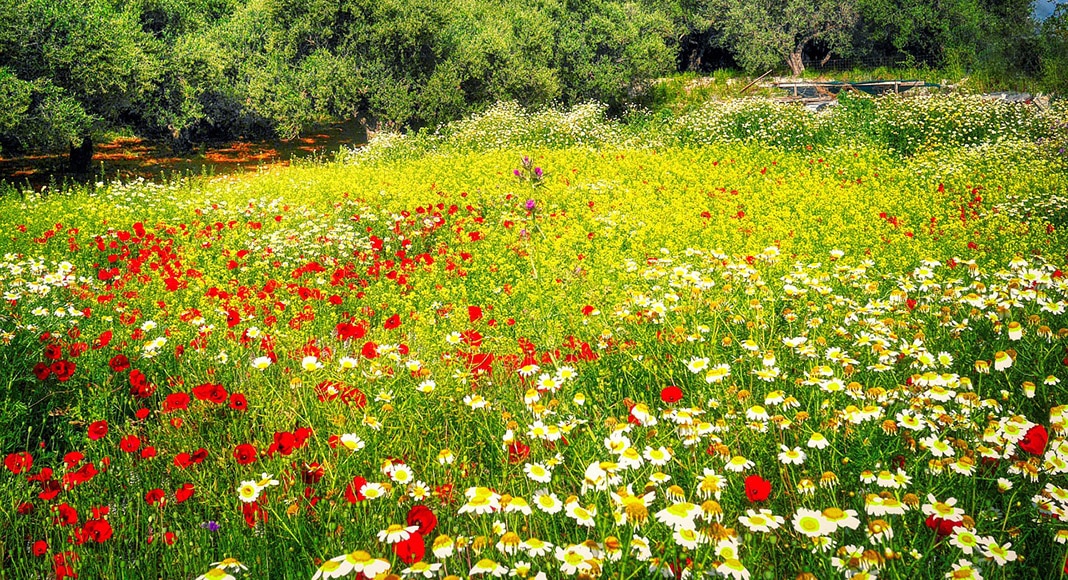Wildflowers are a wonderful way to introduce nature or create a new feature in your garden. They are beneficial for wildlife, to the environment in general and to us, including our mental health. Even better, bees love them. In recent years, there has been increasing interest in establishing wildflower landscapes, but this year that interest has risen to new levels.
Wildflowers are beneficial to nature as they support biodiversity and can even be used to reintroduce nature to a damaged landscape. This is particularly relevant in Mediterranean climate zones. Given the rising level of interest in establishing wildflower areas, why not make a small area in your own garden? Now is the time to prepare and sow your own Mediterranean wildflower meadow.
Many studies show the benefits of green spaces and connecting with nature for human health and wellbeing – a major lesson learned during lockdown. Wildflower meadows bring wildlife into the garden and increase the therapeutic, aesthetic and seasonal interest. The spring flowering time is the peak viewing season, but summer golds and bronzes have their own interest and contrast well with the predominant evergreen shrubs and trees.
It is not recommended to mix lawn turf with wildflowers in warm climates. Native plants normally prefer a poor soil, which cuts down the competition, and there is no need for irrigation. The benefits of a wildflower meadow include ease of maintenance and no costly irrigation systems. Add to that no need for chemical treatments and it is a winning combination.
Use a good-quality seed mix that has good germination and prepare the ground by opening-up compacted soils. Growing meadow areas from seed can require patience, but it will be a lot cheaper than buying in individual plants and will give more natural aspect.
Before any preparation work commences, think about a design for the meadow or wildflower area, mark out paths and any hard landscaping areas.
Geology and climate are major factors to consider when choosing wildflower mixes; soil type and aspect must be included in your choice of seed mix. Soil fertility should be looked at prior to sowing or planting as, ideally, the soil or planting medium should be as low in nutrients as possible.
Cultivation techniques will vary and can range from ploughing and harrowing to using a walk-behind rotary cultivator or tiller and, for smaller areas, hand digging and raking. However it is undertaken, the result needs to be an area free of alien invasive plants with a crumbly tilth. There should be no need to remove small rocks and stones as these are a great help to germination and improve drainage.
Seed for small areas is best spread by hand and the different sizes of seeds in a mixture should be taken into account. When sowing 100% wildflower seed mixtures, only a small amount of seed will be needed – perhaps just 1-2g per square metre. As some perennial species do not flower until the second year, additional colour can be provided in year one by adding 1-2g/sqm of annuals.
If you have collected seed from native plants in your area, then add them into the mix. It can be helpful to add a bulking agent, such as sawdust or sand to help the flow of seed, and to help identify where your seed has landed! If possible, lightly roll or tread the ground afterwards to ensure good contact between the seed and the moisture in the soil. If dry weather prevails, water the area in the first few weeks so that the seed does not dry out. Use a fine spray to avoid washing seed out of the top layer of soil.
Sowing is best carried out in autumn and through the winter until early spring at the very latest. Autumn sowing has advantages and can be more effective as this tends to give stronger, more diverse germination for the following spring. It is also possible to sow into existing wildflower areas, although success can vary.
Use a 100% wildflower seed mix and sow into patches of prepared bare soil. This can add to diversity and augment the selection of plants beneficial to insects and pollinators.
Your new meadow should be allowed to flower and set seed before cutting in summer. This allows the fallen seeds to germinate and you will have more plants establishing themselves in the following year.
Wildflower meadows can mitigate pollution, slow erosion and aid water penetration as well as substantially reduce costs – why not replace your lawn with a wildflower meadow?
Suppliers of seed in Portugal:
Prepared native meadow mixes available from Sementes de Portugal https://www.sementesdeportugal.pt/product-category/prados-floridos-e-apicolas/
Organic seed:
https://www.sementesvivas.bio/pt/
Flower seed mixes:
https://growit.pt/categoria-produto/misturas-de-flores/
https://www.germisem.com/categoria-produto/sementes/espacos-verdes-misturas-meliferas/
Online talk by Olivier Filippi on lawn alternatives including flowering meadows:
https://www.mgaportugal.org/oliv_fil_video.html
By Rosie Peddle
|| features@algarveresident.com
289 791 869 | mgapsec@gmail.com
www.mgaportugal.org



























